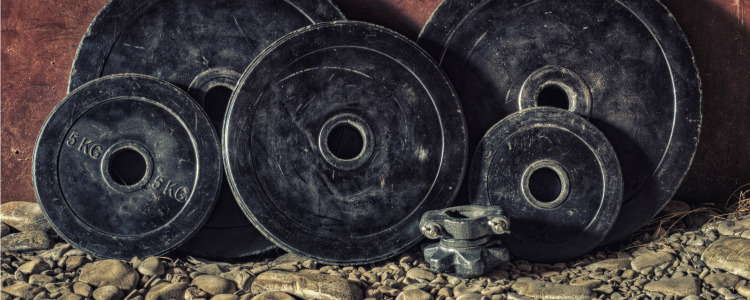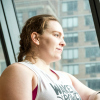How Weight Lifting Helped Me Recover
Once upon a time… Well, this is no fairytale. I want to start at the end and work my way back, like one of those flashback episodes of a TV crime drama. So here goes, my name is Kymberly. Currently, I live in NYC and am working on building a career out of my everything passions art and dance, helping people feel and live better, and lifting heavy things. So far, so good. What’s interesting to me, however, is that when I look back on everything I’ve been through and everything I’ve accomplished, I see it’s in fact the struggles I’ve faced that have made me successful at what I do. That might be a little cliché but it’s true. I want to keep this short, sweet, and to the point, so here’s the condensed version of my story and my journey to happiness and healthy.
I first started to notice my body in middle school when kids were mean, and my internal compare-o-meter developed heavily. Then I noticed it more in high school when the bullies weren’t just my peers but mentors, as well. As an impressionable teenager I internalized their words and thought if I could change, they would see me in a better light. I tried “dieting” here and there, but it wasn’t until my sophomore gym class that my disordered thinking began. I was taught in that gym class how to calculate my BMI, height and weight, as well as what my that “meant.” This number scared me. I was already trying to lose weight because I thought I needed to, and now I had a number besides the one on the scale that told me I was too big. In that same class I was also told that running was the best way to lose weight. So, I decided I would learn to love running! I ran as often as I could force myself to. As with most things we don’t really want to do, I would fall off the bandwagon, blame myself for being lazy, and decide again to be that runner I had in my head. If only I knew then what I know now!
I’ve often thought that gym class should be designed based on the three main body types; mesomorph, endomorph and ectomorph. Kids who are good at running and like running should be able to run. Teach them the kind of strength they’ll need to run better and then let them run like the wind. But the kids who aren’t good at running or don’t really care for it shouldn’t have to feel crappy about themselves being lapped repeatedly by naturally gifted runners. Let those kids lift! Again, teach them the kind of cardio that will help them be balanced and better lifters, but at the end of the day if kids are doing and learning things more specific to their bodies and their interests, they’re going to be more consistent with physical activity as adults, and they’ll also gain confidence. That confidence, I believe, would also help combat pressure from media to try and fit a narrow mold.
The first turning point came my junior year of high school when, in another attempt to continue to lose weight, I thought I’d hit two birds with one stone and take a dance class since I had dreams of performing someday. I saved up what I could and, with the help of my hard-working parents, joined a class at my local dance studio. By that time, I was so depressed and lost that I felt I wasn’t good enough for anything. But the teacher saw something in me and encouraged me to take more classes. She even let me organize around the studio and during shows to help with costs. Dance was a language I could speak. Movement became a remedy to my body image issues. When I was dancing, I felt free. She gave me a confidence that carried me through high school. When she suggested I major in dance at the University of Wisconsin-Stevens Point, I auditioned and, to my surprise, was accepted!
Not everyone who struggles with disordered eating looks the same. My body naturally carries muscle mass and curves, even when I struggled with an eating disorder. Anytime, I was active in my eating disorder, everyone would compliment me and tell me I looked so good and was doing a great job. Talk about positive reinforcement of a detrimental behavior!
After college, I spent a year living with one of my sisters and her family in the Twin Cities. I also started training with a personal trainer. He had me start lifting weights. In one of our first sessions, he had me on a leg press to see how much I could do. I don’t even know what the final amount was but he was impressed. That made me feel good and strong. When I later became a trainer, I realized that when I feed my body, I can lift better and feeling strong felt better than an empty stomach felt. So, while I lived there, I still yo-yoed a bit but working with a trainer refocused my mind.
I moved to New York City with a couple of suitcases and a friend’s couch to sleep on for a few weeks. A year or so after starting my first job there at a cute little wine bar/cheese shop/cafe on the Upper East Side, depression started to creep back into my life as I slowly started moving less and turning back to food for comfort. Back on the swing, I was. This time, though, I decided I would go see a health coach. I slowly started opening up to her about what I was struggling with and, even though I kept parts I wasn’t ready to share to myself, she seemed to have this beautiful way of making me feel like she understood. We were talking one day when I told her about a time in high school, when we were learning about weight lifting, that I thought about becoming a trainer. She asked why I didn’t look in to a program. Following her advice, I completed a training program and was soon hired by the gym.
The program taught me training basics and helped me have an epiphany: running wasn’t the best way for me to be healthy, and that goal weight I had held onto wasn’t the most important indicator in my life. The night after realizing that, I went home and cried as I felt a little pressure lift off my shoulders. Once I started working out consistently in a balanced way for the first time in my life and working with clients, the frame within which I viewed everything (particularly myself) started to shift. I felt my body start to change; I was getting stronger and I could feel my body move in a different way than it had before. Not to mention, I had energy when I wasn’t overtraining like I had in the past.
Balancing weights with activities I loved, like dance and eating, gave me a pep in my step. For the first time, I wasn’t trying to make myself smaller. I was just moving and exploring my body’s limits with weights. A “fail” was a good thing because it indicated I was finding myself. The pride I felt in that was so different than falling out of a turn in dance class. A “fail” didn’t make me a bad lifter, it made me a better one. I knew that the next time I would lift that weight, I would succeed; that is simply how the body adjusts to new weight. Even more importantly, I started to believe that if I ate better, I would lift better each time. So, food became increasingly less scary and triggering.
It was through seeing my body move weights that looking in the mirror stopped triggering me. I started to like watching myself lift. I would notice similarities in the ways my clients and I saw ourselves. There is something magical in thinking about your body getting stronger instead of a number.
Next, as an exercise specialist, I worked with more people, gained more strength, and started sharing my ideas of how to build a healthy, balanced life. I’ve always been a believer in finding what works for you. Medication or therapy help many. What helped me was learning what my body needs to function at its best. My body loves to lift, I feel my best mentally and physically when I’m moving and particularly when I’m exploring my limits.
Finally, I want to note that, even though it sounds like I’m “on the other side,” there really is no other side. I still go through times when I want to, and do, turn to food for comfort. Life ebbs and flows, my depression comes back here and there. Just last year, I had a couple injuries that prevented me from working out the way I like to and I found myself struggling again with old thoughts and patterns. I took a pause and reset my mind to everything I had learned. I’ve come to accept these thoughts and patterns might always be there. However, I now have the knowledge and awareness to remind myself that I’m human. With time, my injuries healed, and I’m back to playing with weights in the gym.
I have a beautiful body that is capable of so many awesome things. I don’t diet; I eat for my goal, which is to be as strong as I can be while also being able to dance with reckless abandon. For me, it was through strength training that I learned to love my body as it is.
Kymberly Tera is a New York based exercise specialist, entrepreneur, and artist. She has built a career out of her passion for movement through dance and training, as well as a deep desire to help people feel better. A published author and creator, Kymberly encourages her clients to learn their bodies to build a healthy lifestyle that fits their unique needs and goals. Her mission is to promote body diversity and understanding of how different body types achieve health through her website definehealthy.net.





